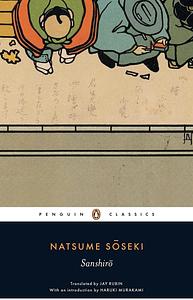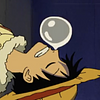Take a photo of a barcode or cover
A year (or so) in the life of a young man who moves to the city & tries to find his way in the world.
emotional
inspiring
mysterious
reflective
sad
slow-paced
Plot or Character Driven:
Character
Strong character development:
Complicated
Loveable characters:
Yes
Diverse cast of characters:
N/A
Flaws of characters a main focus:
Complicated
funny
inspiring
lighthearted
reflective
medium-paced
Plot or Character Driven:
N/A
200’lü sayfalara kadar çok güzel ilerledi. Aramızda 100 küsür yıllık zaman farkı olmasına rağmen üniversitenin ilk senelerinde yaşadığım deneyimlerin çok benzerlerini ana karakterin yaşadığını hissettim. Sona doğru 1900’lerin Japonya’sının gerçekliğinin ağır basmasıyla kitap ve ana karakterle kurduğum yakınlık biraz zedelense de Sanşiro, son zamanlarda okuduğum en güzel roman diyebilirim.
funny
inspiring
lighthearted
reflective
slow-paced
Plot or Character Driven:
Character
Strong character development:
Complicated
Loveable characters:
Yes
Diverse cast of characters:
No
Flaws of characters a main focus:
Complicated
“Tokyo is bigger than Kumamoto. And Japan is bigger than Tokyo. And even bigger than Japan…Even bigger than Japan is the inside of your head. Don’t ever surrender yourself—not to Japan, not to anything.”
Technically the second time I’ve read something by Natsume Soseki (I read half of I Am a Cat, doesn’t really count). His writing, and Jay Rubin’s translation, has this kind of whimsical feel to it. It can easily be funny as it can be profound. This book delivered way more than what I was expecting. Nothing happens in the story, it was about some country boy who moved to Tokyo for university. Yet in between the nothingness—Sanshiro hangs out with friends, Sanshiro tries to return borrowed money, Sanshiro struggles with women—Natsume Soseki somehow delivered thought-provoking social commentaries. He really captured the essence of the Meiji era, a time of modernization, Westernization, and a general conflict between old and new for Japan. Not only that, he was able to make the main character relatable and the dynamics intriguing. I understood everything Sanshiro felt, a university student living in the city, with older generations he look up to and peers he try to connect to, with the vague feeling that in a society that is rapidly changing, he was apart of something bigger than himself. I’d love to read this in its original language someday.
Technically the second time I’ve read something by Natsume Soseki (I read half of I Am a Cat, doesn’t really count). His writing, and Jay Rubin’s translation, has this kind of whimsical feel to it. It can easily be funny as it can be profound. This book delivered way more than what I was expecting. Nothing happens in the story, it was about some country boy who moved to Tokyo for university. Yet in between the nothingness—Sanshiro hangs out with friends, Sanshiro tries to return borrowed money, Sanshiro struggles with women—Natsume Soseki somehow delivered thought-provoking social commentaries. He really captured the essence of the Meiji era, a time of modernization, Westernization, and a general conflict between old and new for Japan. Not only that, he was able to make the main character relatable and the dynamics intriguing. I understood everything Sanshiro felt, a university student living in the city, with older generations he look up to and peers he try to connect to, with the vague feeling that in a society that is rapidly changing, he was apart of something bigger than himself. I’d love to read this in its original language someday.
Great read, if you enjoyed Norwegian Woods you’ll like this book.
This is a both coming of age story of a boy from the provinces starting university in Tokyo and a commentary on Japan’s transition as it starts opening itself up to the world and other cultures as it enters the industrial era/Meiji period
Sanshiro is an innocent stray sheep in big Tokyo, observing but not always knowing how to react.
This is a both coming of age story of a boy from the provinces starting university in Tokyo and a commentary on Japan’s transition as it starts opening itself up to the world and other cultures as it enters the industrial era/Meiji period
Sanshiro is an innocent stray sheep in big Tokyo, observing but not always knowing how to react.
challenging
funny
lighthearted
reflective
medium-paced
Plot or Character Driven:
Character
Strong character development:
No
Loveable characters:
No
Diverse cast of characters:
Yes
Flaws of characters a main focus:
Yes
Sanshiro leaves his provincial home to attend university in Tokyo. While there, he is introduced to an intellectual milieu that he doesn't really understand. He and a young woman, who is connected to the sophisticated circles of Tokyo, develop and attraction for one another, but their differences are too great and they do not pursue it. This is a gently melancholic novel, told in a detached and somewhat flat style. I enjoyed some of the scenes and the descriptions of the different people, but the plot is very slight, and I did not feel that the characters were written with sufficient depth to make up for this.
I was surprised by my level of identification and sympathy with the protagonist. Soseki has a way of communicating the awkwardness, cowardice, and wonder that small town people can experience when trying to forge an identity in a major metropolis. The contemplative pacing and overall focus on Sanshiro's (occasionally dimwitted) inner life may not appeal to all readers, but I found something in there that truly hit home. Truly enjoyed the read.
Although written in late Meiji Japan and I went to school in Santa Cruz in the 90s somehow I found a lot of nostalgia and relatability in Sanshiro's meanderings as a first year student at Todai.






